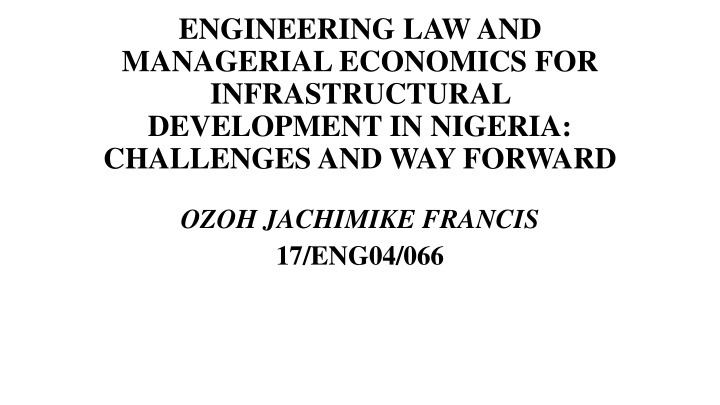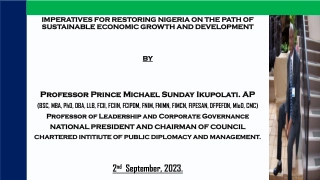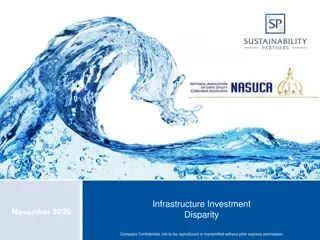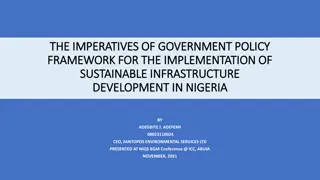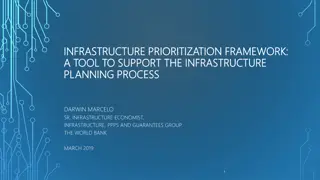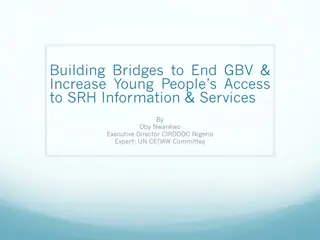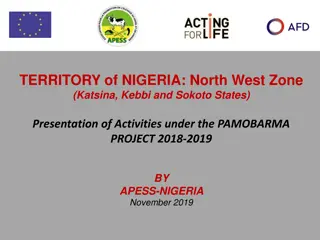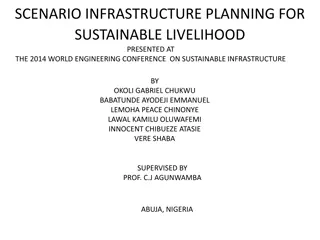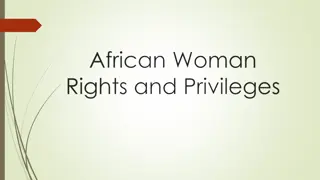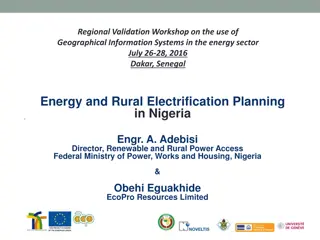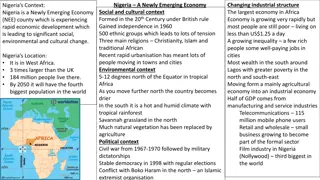Challenges and Solutions for Infrastructure Development in Nigeria
Nigeria faces challenges in meeting its infrastructure needs with backlogs in investments. The Twelfth Five Year Plan aims to raise infrastructure spending to 8% of GDP. Issues in road, rail, and air transportation highlight areas needing improvement for sustainable development.
Download Presentation

Please find below an Image/Link to download the presentation.
The content on the website is provided AS IS for your information and personal use only. It may not be sold, licensed, or shared on other websites without obtaining consent from the author.If you encounter any issues during the download, it is possible that the publisher has removed the file from their server.
You are allowed to download the files provided on this website for personal or commercial use, subject to the condition that they are used lawfully. All files are the property of their respective owners.
The content on the website is provided AS IS for your information and personal use only. It may not be sold, licensed, or shared on other websites without obtaining consent from the author.
E N D
Presentation Transcript
ENGINEERING LAW AND MANAGERIAL ECONOMICS FOR INFRASTRUCTURAL DEVELOPMENT IN NIGERIA: CHALLENGES AND WAY FORWARD OZOH JACHIMIKE FRANCIS 17/ENG04/066
SECTOR BACKLOGS In spite of the rising expenditure figures, investments in Indian Infrastructure fall well short of the country s requirements. First, in many cases, the current infrastructure is inadequate even for current needs. i.e., there are backlogs of investments in several sectors. Second, current infrastructure is not likely to meet tomorrow s needs. i.e., with the rise of population and economy, there will be more demand for infrastructure of good quality and in good quantity. Both the above clearly indicate that India needs its infrastructure to be developed.
SECTOR TARGETS The Twelfth Five Year Plan (FYP) has laid down the target amount of money spent on infrastructure to be raised to 8% of GDP (earlier, infrastructure spending was only 4.6% of GDP) and one half of all new investments in the 11th plan were in infrastructure. The Planning Commission has estimated that a total investment of $450 Billion in infrastructure is required over the next 5 years to meet India s infrastructure needs over 5 years The XII FYP has set targets for various infrastructure sectors.
ISSUES OF INFRASTRUCTURE DEVELOPMENT ISSUES OF INFRASTRUCTURE DEVELOPMENT Roads In spite of the significant achievements made under Golden Quadrilateral Project, the subsequent phases of road development under NHDP suffered due to multitude of problems. These range from funds crunch at NHAI to its supervision capabilities to the implementation hurdles due to various clearances required. In fact, it even led to some of the leading private road developers who were awarded construction contracts, threatening to cancel concession contracts.
Railways For a long time after the revival of fortunes, Indian railways has been experiencing a stagnation in growth. This situation is brought out by the railway ministers coming from the eastern part of the country doling out disproportionately large benefits to their states without any concern for or at the expense of other states, especially those in South. Their populist measures ruined the finances of railways and made their operations one of the most unsafe in the world. The railways have to fix up their finances with tariff rebalancing for correcting the imbalance of passenger and freight tariff as well as cross-subsidisation within passenger tariff between various classes.
Airports Although India has witnessed tremendous improvement in airline travel, there has not been an equivalent improvement in air traffic control services such ground facilities, cargo handling, commercial activities/ hub facilities. There is also a need to modernize DGCA, which works on age old methods to make decisions and without any concern for airport security and passenger safety. One major improvement could come from the private sector participation in airport infrastructure development and operations especially through PPPs.
Seaports The seaports sector held lot of promise and was most desired when India was to liberalise economy and open up trade and commerce. However, there has been a concentration of traffic and freight in major ports and minor ports did not show any operational improvement. One of the reasons cited is the predatory pricing of some large ports, which calls for regulatory mechanism for both operations and schedules as well as pricing and services. A legal framework is yet to develop and there is an need to decongest major ports, which account for a majority of freight.
Telecommunication Telecommunication witnessed significant changes in several segments but some issues still remain. There is monopoly in wired-telephony with BSNL and MTNL as the players and oligopoly in wired loop link (WLL) telephony with few players like Tata and Reliance. The open competition in mobile telephony is yet to benefit the rural masses in a significant manner. The recently highlighted issues of corruption in 2G spectrum allocation and the problems of releasing available spectrum are acting as deterrents to further progress. This calls for addressing governance issues in spectrum allocation such as corruption, non-transparency, non-competitive allocation and rent seeking.
Urban Infrastructure Urban infrastructure is a sector that suffered long time due to inadequate investments into and no availability of finance. The poor orientation of ULGs on service provision on one hand and inadequate own finance and inter-government grants on other hand made the services not at the level required. The non-access to public/ market debt deepened it and poor levels of cost recovery (even O&M) accentuated. For a long time, inter-governmental nature of financing (in the system of public finance) urban infrastructure made the projects and funding to come with time lags resulting in cost escalation.
CONCLUSION The negative and significant impact of gross capital formation and federal spending on transport and communication may be attributed largely to corruption. In some cases, the projects are carried out, but not done efficiently (done with substandard materials that will cause the infrastructure to break down in the near future); sometimes, the work is done efficiently but takes too long to be finished, and more capital is required and spent for what could have been finished a long time ago (sometimes years) on the same project. It is also necessary that government puts measures in place to curb corruption in the system, so that, the money disbursed for infrastructural development is properly channelled. An inspection is necessary to further ensure that the works (the constructions, etc.) are done right, to make the infrastructure more reliable. This will equally boost output of the industrial sector.
